 Facebook
Facebook
 X
X
 Instagram
Instagram
 TikTok
TikTok
 Youtube
Youtube
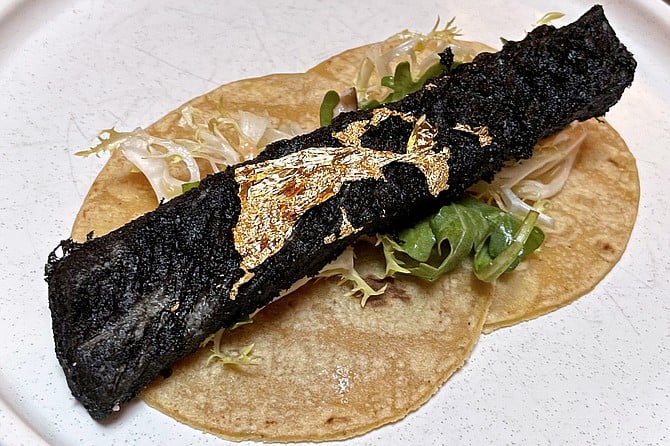
It’s a fish taco so long, it comes wrapped in two corn tortillas, laid end to end. So blackened by squid ink tempura, you might never guess that impeccably cooked white fish lies within. So upscale, it relies on a topcoat of edible gold leaf to justify its $18 price tag. Dubbed simply, “The Taco,” this unusual specimen numbers one of the many talked-about dishes served by Camino Riviera, the Tulum, Mexico-inspired restaurant that opened in Little Italy late last year.
Home to ancient Maya ruins, and one of the world’s finest white sand coastlines, Tulum has become something of a status destination to N.Y.C. and L.A. cultural elites, the ballyhooed stomping ground of “digital nomads.” As a result, the place has developed its own distinct culture of sorts: a quasi-bohemian amalgam of spring break, Instagram, and Burning Man, characterized by wooded artworks, thatched rooftops, and unchecked day-drinking.
Which isn’t to say it’s developed its own cuisine, per se, but the consistent flow of affluent and high-minded vacationers has attracted plenty of ambitious chefs and restaurateurs. World-renowned chef René Redzepi hosted a pop-up restaurant there in 2017 while his famed Copenhagen restaurant, Noma, was closed for renovation. If vacationers didn’t show up looking to spend gobs of money at Tulum restaurants before that, they certainly have since. I would wager Tulum diners on average are prepared to spend more on dinner than San Diegans.
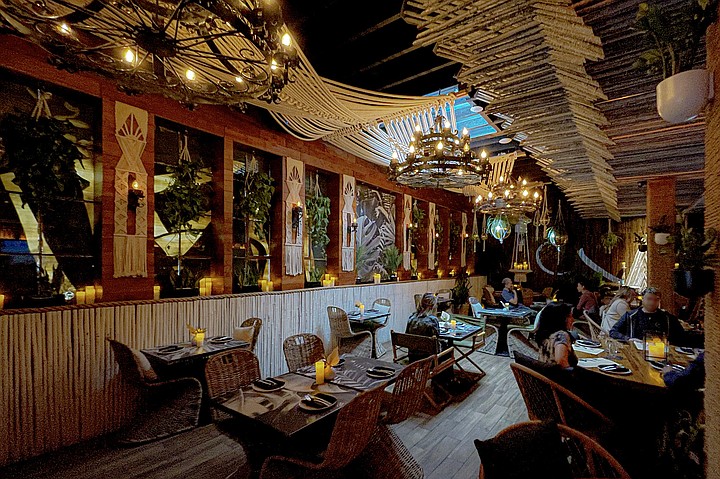
In Tulum, this too often means pretension. For example, a highly regarded restaurant I visited during my Tulum honeymoon felt it could improve on the humble corn tortilla chip by making it more closely resemble a matzo cracker, served with avocado foam, at 12 bucks for three chips. You might get away with that when you know all of tonight’s dinner guests fly home on Monday.
In this regard, Camino Riviera proves worth the squeeze. Though its perch — just below the southbound lanes of the 5 freeway — shouldn’t be able to compete with beachy Caribbean atmosphere, a gorgeous interior décor combines bamboo, macrame, and tropical plants do nail the vibe. Out back, a dining patio and bar features tile and stone, and likewise feels lifted from the courtyard of a Riviera Maya hotel.
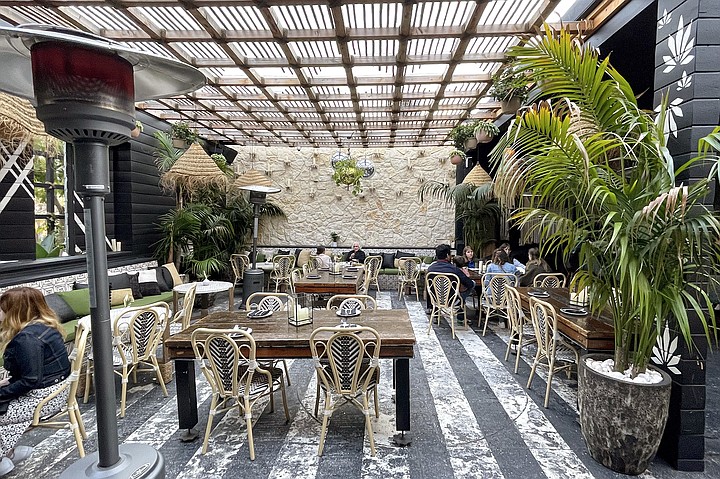
Better yet, Camino Riviera has executive chef Brian Redzikowski, who has consistently proven himself one of San Diego’s best, whether creating Michelin-praised entrees for Camino sister restaurant, Kettner Exchange, or churning out the city’s top donuts at its adjacent window counter, Devil’s Dozen.
So that gilt fish taco? Take away the gold leaf and the squid ink, and you’re left with an outstanding, fried sea bass, fish taco. It’s overpriced by ten bucks, and not as spicy as I’d prefer, but perfectly rendered.
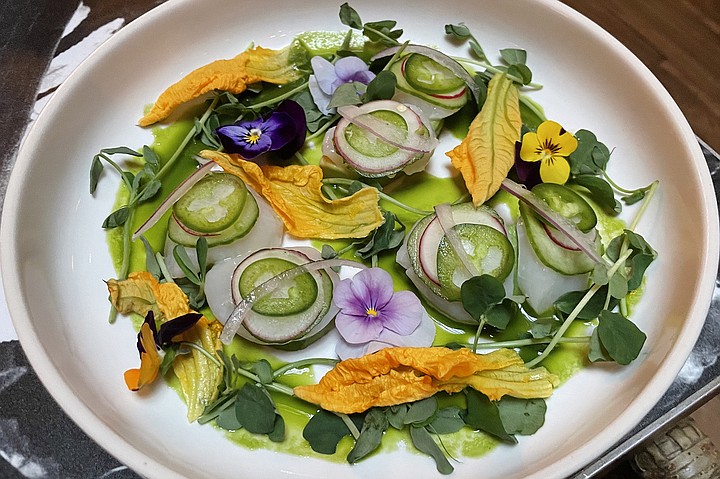
Of course, conversation is the point. Much of the menu here rides this interesting high-brow/low-brow line, like it’s searching for ways to make Mexican street food worth a celebratory second look. Another example is the $17 scallops aquachile, which elevates the cheap shrimp, mariscos truck staple with loftier shellfish and edible flowers. Or the $16 pork quesabirria bao, a mash-up of cheesy birria taco in the guise of a pork belly bao.
More interesting still is the $16 “gordita crunch.” This one takes the Taco Bell idea of combining soft flatbread with the crunch of a hard corn tortilla, except with bao instead of flatbread. So it’s like a tostada stuck on top of a steamed bun, topped with salpicon, a Latin American mixture of cold, shredded beef. In this case, use of wagyu beef justifies the price tag, while the simple act of combining the culturally distinct flavors and textures of bao and tortilla ensure the dish finds success beyond its own novelty.
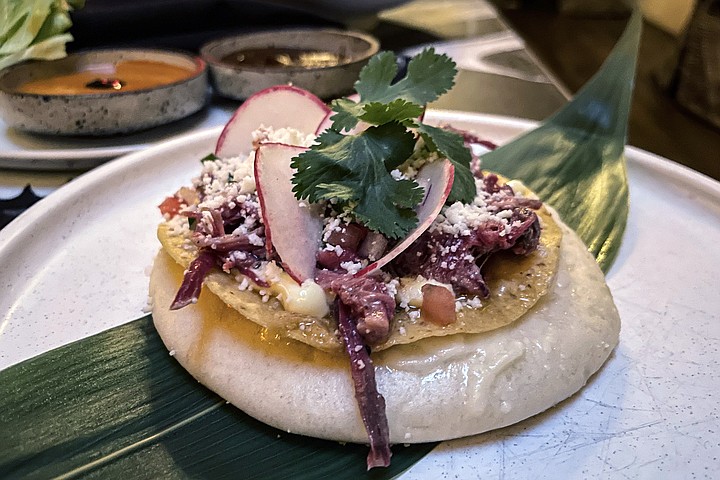
Whether it’s 16-dollars memorable may depend on your perspective. Think of these items in terms of Mexican dishes, and — like “The Taco” — and it feels like too much. Even in Tulum, you can leave the beach area to find cheap, tasty taco shops. To me, Camino Riviera feels more successful viewed as a contemporary dining destination, rather than a pricy Mexican eatery. At least, that’s what I decided when I tried the $35 Sonoma lamb shoulder barbacoa.
I was told the lamb is cooked over an oak flame, in a pot with its own juices, and finished in a pan prior to serving. It’s then served on banana leaves with corn tortillas, to make into tacos with toppings of butter lettuce, cucumbers, radishes, onions, and cilantro, plus two types of creamy salsas. I dutifully started assembling a taco, and made it all the way through eating one before it occurred to me: this chili-rubbed lamb is far too good waste on a taco.
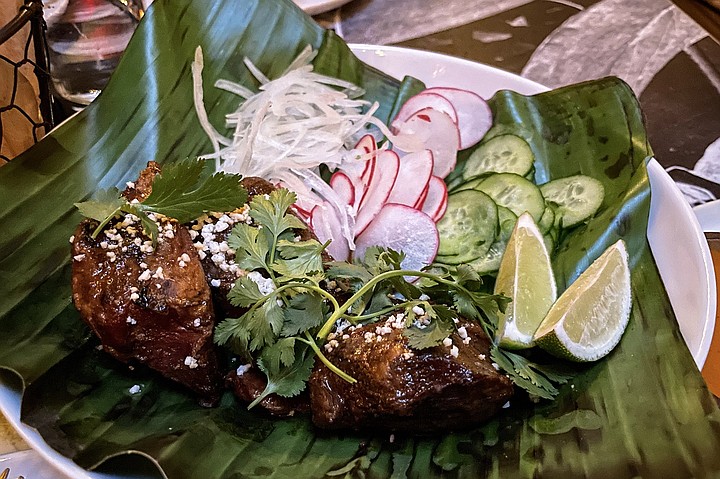
That hurts to admit. At a casual barbacoa spot, the tortillas and salsas would enhance the meal. Here, they almost couldn’t keep up, and detracted from a superbly cooked and seasoned lamb shoulder.
For those who party in Tulum, its natural beauty is too often obscured by its own instagrammable trappings. Camino Riviera’s imitation of a Tulum restaurant might too closely follow that lead. It’s far more expensive than the best Mexican food, but look past the style, and there is food worth its weight in gold leaf.


It’s a fish taco so long, it comes wrapped in two corn tortillas, laid end to end. So blackened by squid ink tempura, you might never guess that impeccably cooked white fish lies within. So upscale, it relies on a topcoat of edible gold leaf to justify its $18 price tag. Dubbed simply, “The Taco,” this unusual specimen numbers one of the many talked-about dishes served by Camino Riviera, the Tulum, Mexico-inspired restaurant that opened in Little Italy late last year.
Home to ancient Maya ruins, and one of the world’s finest white sand coastlines, Tulum has become something of a status destination to N.Y.C. and L.A. cultural elites, the ballyhooed stomping ground of “digital nomads.” As a result, the place has developed its own distinct culture of sorts: a quasi-bohemian amalgam of spring break, Instagram, and Burning Man, characterized by wooded artworks, thatched rooftops, and unchecked day-drinking.
Which isn’t to say it’s developed its own cuisine, per se, but the consistent flow of affluent and high-minded vacationers has attracted plenty of ambitious chefs and restaurateurs. World-renowned chef René Redzepi hosted a pop-up restaurant there in 2017 while his famed Copenhagen restaurant, Noma, was closed for renovation. If vacationers didn’t show up looking to spend gobs of money at Tulum restaurants before that, they certainly have since. I would wager Tulum diners on average are prepared to spend more on dinner than San Diegans.

In Tulum, this too often means pretension. For example, a highly regarded restaurant I visited during my Tulum honeymoon felt it could improve on the humble corn tortilla chip by making it more closely resemble a matzo cracker, served with avocado foam, at 12 bucks for three chips. You might get away with that when you know all of tonight’s dinner guests fly home on Monday.
In this regard, Camino Riviera proves worth the squeeze. Though its perch — just below the southbound lanes of the 5 freeway — shouldn’t be able to compete with beachy Caribbean atmosphere, a gorgeous interior décor combines bamboo, macrame, and tropical plants do nail the vibe. Out back, a dining patio and bar features tile and stone, and likewise feels lifted from the courtyard of a Riviera Maya hotel.

Better yet, Camino Riviera has executive chef Brian Redzikowski, who has consistently proven himself one of San Diego’s best, whether creating Michelin-praised entrees for Camino sister restaurant, Kettner Exchange, or churning out the city’s top donuts at its adjacent window counter, Devil’s Dozen.
So that gilt fish taco? Take away the gold leaf and the squid ink, and you’re left with an outstanding, fried sea bass, fish taco. It’s overpriced by ten bucks, and not as spicy as I’d prefer, but perfectly rendered.

Of course, conversation is the point. Much of the menu here rides this interesting high-brow/low-brow line, like it’s searching for ways to make Mexican street food worth a celebratory second look. Another example is the $17 scallops aquachile, which elevates the cheap shrimp, mariscos truck staple with loftier shellfish and edible flowers. Or the $16 pork quesabirria bao, a mash-up of cheesy birria taco in the guise of a pork belly bao.
More interesting still is the $16 “gordita crunch.” This one takes the Taco Bell idea of combining soft flatbread with the crunch of a hard corn tortilla, except with bao instead of flatbread. So it’s like a tostada stuck on top of a steamed bun, topped with salpicon, a Latin American mixture of cold, shredded beef. In this case, use of wagyu beef justifies the price tag, while the simple act of combining the culturally distinct flavors and textures of bao and tortilla ensure the dish finds success beyond its own novelty.

Whether it’s 16-dollars memorable may depend on your perspective. Think of these items in terms of Mexican dishes, and — like “The Taco” — and it feels like too much. Even in Tulum, you can leave the beach area to find cheap, tasty taco shops. To me, Camino Riviera feels more successful viewed as a contemporary dining destination, rather than a pricy Mexican eatery. At least, that’s what I decided when I tried the $35 Sonoma lamb shoulder barbacoa.
I was told the lamb is cooked over an oak flame, in a pot with its own juices, and finished in a pan prior to serving. It’s then served on banana leaves with corn tortillas, to make into tacos with toppings of butter lettuce, cucumbers, radishes, onions, and cilantro, plus two types of creamy salsas. I dutifully started assembling a taco, and made it all the way through eating one before it occurred to me: this chili-rubbed lamb is far too good waste on a taco.

That hurts to admit. At a casual barbacoa spot, the tortillas and salsas would enhance the meal. Here, they almost couldn’t keep up, and detracted from a superbly cooked and seasoned lamb shoulder.
For those who party in Tulum, its natural beauty is too often obscured by its own instagrammable trappings. Camino Riviera’s imitation of a Tulum restaurant might too closely follow that lead. It’s far more expensive than the best Mexican food, but look past the style, and there is food worth its weight in gold leaf.
Comments